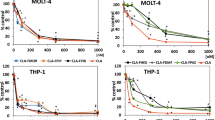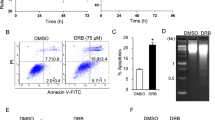Abstract
The mechanism of apoptosis induced by 2-chloro-2′-deoxyadenosine (2CdA) in human leukemia cell line MOLT-4 was investigated. 2CdA induced increases of 3′-OH ends of genomic DNA, ladder-like DNA fragmentation and phosphatidylserine translocation to the outer membrane, which are apoptotic characteristics. These apoptotic phenomena induced by 2CdA were inhibited by cycloheximide (CHX; a protein synthesis inhibitor), deoxycytidine (dC; a substrate of deoxycytidine kinase), acetyl Ile-Glu-Thr-Asp aldehyde (Ac-IETD-CHO; a caspase-8 inhibitor) and acetyl Asp-Glu-Val-Asp aldehyde (Ac-DEVD-CHO; a caspase-3 inhibitor). The protein synthesis-dependent expression of Fas and Fas ligand (Fas-L) was detected by treatment with 2CdA. The proteolytic processing of procaspases-8 and -3 to produce active fragments, caspases-8 (p18) and -3 (p17), respectively, was observed after treatment with 2CdA, and suppressed by cycloheximide. Increases in the activities of caspases-8 and -3 were observed after 2CdA treatment. Their activation was also dependent on protein synthesis. These results indicated that 2CdA-induced apoptosis was triggered by phosphorylation of 2CdA followed by the protein synthesis-dependent expression of Fas and Fas-L and activation of caspases-8 and -3.
This is a preview of subscription content, access via your institution
Access options
Subscribe to this journal
Receive 12 print issues and online access
$259.00 per year
only $21.58 per issue
Buy this article
- Purchase on Springer Link
- Instant access to full article PDF
Prices may be subject to local taxes which are calculated during checkout






Similar content being viewed by others
References
Saven A, Lemon RH, Kosty M, Beutler E, Piro LD . 2-Chlorodeoxyadenosine(2-CdA) activity in patients with previously untreated chronic lymphocytic leukemia (CLL) Blood 1993 82: 445a
Tallman MS, Hakimian D, Variakojis D, Koslow D, Sisney GA, Rademaker AW, Rose E, Kaul K . A single cycle of 2-chlorodeoxyadenosine results in complete remission in the majority of patients with hairy cell leukemia Blood 1992 80: 2203–2209
Huang M, Ashmun RA, Avery TL, Kuehl M, Blakley RL . Effects of cytotoxicity of 2-chloro-2′-deoxyadenosine and 2-bromo-2′-deoxyadenosine on cell growth, clonogenicity, DNA synthesis, and cell cycle kinetics Cancer Res 1986 46: 2362–2368
Keane RW, Srinivasan A, Foster LM, Testa MP, Ord T, Nonner D, Wang HG, Reed JC, Bredesen DE, Kagalar C . Activation of cpp32 during apoptosis of neurons and astrocytes J Neurosci Res 1997 48: 168–180
Verhoven B, Schlegel RA, Williamson P . Mechanisms of phosphatidylserine exposure, a phagocyte recognition signal, on apoptotic T lymphocytes J Exp Med 1995 182: 1597–1601
Cheson BD, Sorensen JM, Vena DA, Montello MJ, Damasio E, Tallman M, Annino L, Connors J, Coiffier B, Lauria F . Treatment of hairy cell leukemia with 2-chlorodeoxyadenosine via the group C protocol mechanism of the National Cancer Institute: a report of 979 patients J Clin Oncol 1998 16: 3007–3015
Saven A, Burian C, Koziol JA, Piro LD . Long-term follow-up of patients with hairy cell leukemia after cladribine treatment Blood 1998 92: 1918–1926
Robak T, Blasinska-Morawiec M, Blonski J, Hellmann A, Halaburda K, Konopka L, Kotlarek-Haus S, Potoczek S, Hansz J, Dmoszynska A, Urasinski I, Zdziarska B, Dwilewicz-Trojaczek J, Holowiecki J, Skotnicki AB . 2-Chlorodeoxyadenosine (cladribine) in the treatment of hairy cell leukemia and hairy cell leukemia variant: 7-year experience in Poland Eur J Haematol 1999 62: 49–56
Fridrik MA, Jäger G, Kienzer HR, Hausmaninger H, Oppitz P, Krieger O, Zabernigg A, Lang A, Neubauer M, Weidinger G, Schiller L, Seewann HL, Chott A, Linkesch W . Efficacy and toxicity of 2-chlorodeoxyadenosine (cladribine) – 2h infusion for 5 days – as first-line treatment for advanced low grade non-Hodgkin's lymphoma Eur J Cancer 1998 34: 1560–1564
Betticher DC, Ratschiller D, Hsu Schmitz SF, von Rohr A, Hess U, Zulian G, Wernli M, Tichelli A, Tobler A, Fey MF, Cerny T . Reduced dose of subcutaneous cladribine induced identical response rates but decreased toxicity in pretreated chronic lymphocytic leukaemia. Swiss Group for Clinical Cancer Research (SAKK) Ann Oncol 1998 9: 721–726
Carson DA, Wasson DB, Esparza LM, Carrera CJ, Kipps TJ, Cottam HB . Oral antilymphocyte activity and induction of apoptosis by 2-chloro-2′-arabino-fluoro-2′-deoxyadenosine Proc Natl Acad Sci USA 1992 89: 2970–2974
Tanabe K, Hiraoka W, Kuwabara M, Sato F, Matsuda A, Ueda T . Induction of DNA double-strand breaks in Chinese hamster V79 cells by 2-chlorodeoxyadenosine Chem–Biol Interactions 1989 71: 167–175
Tanabe K, Hiraoka W, Kuwabara M, Matsuda A, Ueda T, Sato F . Modification of the repair of potentially lethal damage in plateau-phase Chinese hamster cells by 2-chlorodeoxyadenosine J Radiat Res 1988 29: 172–181
Kuwabara M, Tanabe K, Hiraoka W, Tamura Y, Sato F, Matsuda A, Ueda T . 2-Chlorodeoxyadenosine inhibits the repair of DNA double-strand breaks and does not inhibit the repair of DNA single-strand breaks in X-irradiated Chinese hamster V79 cells Chem–Biol Interactions 1991 79: 349–358
Hirota Y, Yoshioka A, Tanaka S, Watanabe K, Otani T, Minowada J, Matsuda A, Ueda T, Wataya Y . Imbalance of deoxyribonucleoside triphosphates, DNA double-strand breaks, and cell death caused by 2-chlorodeoxyadenosine in mouse FM3A cells Cancer Res 1989 49: 915–919
Carson DA, Wasson DB, Kaye J, Ullman B, Martin DW Jr, Robins RK, Montgomery JA . Deoxycytidine kinase-mediated toxicity of deoxyadenosine analogs toward malignant human lymphoblasts in vitro and toward murine L1210 leukemia in vivo Proc Natl Acad Sci USA 1980 77: 6865–6869
Carson DA, Wasson DB, Taetle R, Yu A . Specific toxicity of 2-chlorodeoxyadenosine toward resting and proliferating human lymphocytes Blood 1983 62: 737–743
Seto S, Carrera CJ, Kubota M, Wasson DB, Carson DA . Mechanism of deoxyadenosine and 2-chlorodeoxyadenosine toxicity to nondividing human lymphocytes J Clin Invest 1985 75: 377–383
Kawasaki H, Carrera CJ, Piro LD, Saven A, Kipps TJ, Carson DA . Relationship of deoxycytidine kinase and cytoplasmic 5′-nucleotidase to the chemotherapeutic efficacy of 2-chlorodeoxyadenosine Blood 1993 81: 597–601
Villunger A, Egle A, Kos M, Hartmann BL, Geley S, Kofler R, Greil R . Drug-induced apoptosis is associated with enhanced Fas (Apo-1/CD95) ligand expression but occurs independently of Fas (Apo-1/CD95) signaling in human T-acute lymphatic leukemia cells Cancer Res 1997 57: 3331–3334
Mo YY, Beck WT . DNA damage signals induction of Fas ligand in tumor cells Mol Pharmacol 1999 55: 216–222
Enari M, Sakahira H, Yokoyama H, Okawa K, Iwamatsu A, Nagata S . A caspase-activated DNase that degrades DNA during apoptosis, and its inhibitor ICAD Nature 1998 391: 43–50
Cohen GM . Caspases: the executioners of apoptosis Biochem J 1997 326: 1–16
Bauer MA, Vogt M, Los M, Siegel J, Wesselborg S, Schulze-Osthoff K . Role of reactive oxygen intermediates in activation-induced CD95 (APO-1/Fas) ligand expression J Biol Chem 1998 273: 8048–8050
Fulda S, Scaffidi C, Pietsch T, Krammer PH, Peter ME, Debatin KM . Activation of the CD95 (APO-1/Fas) pathway in drug- and γ-irradiation-induced apoptosis of brain tumor cells Cell Death Differ 1998 5: 884–893
Faris M, Kokot N, Latinis K, Kasibhatla S, Green DR, Koretzky GA, Nel A . The c-Jun N-terminal kinase cascade plays a role in stress-induced apoptosis in Jurkat cells by up-regulating Fas ligand expression J Immunol 1998 160: 134–144
Ferrari D, Stepczynska A, Los M, Wesselborg S, Schulze-Osthoff K . Differential regulation and ATP requirement for caspase-8 and caspase-3 activation during CD95- and anticancer drug-induced apoptosis J Exp Med 1998 188: 979–984
Nagata S . Apoptosis by death factor Cell 1997 88: 355–365
Zou H, Henzel WJ, Liu X, Lutschg A, Wang X . Apaf-1, a human protein homologous to C. elegans CED-4, participates in cytochrome c-dependent activation of caspase-3 Cell 1997 90: 405–413
Li P, Nijhawan D, Budihardjo I, Srinivasula SM, Ahmad M, Alnemri ES, Wang X . Cytochrome c and dATP-dependent formation of Apaf-1/caspase-9 complex initiates an apoptotic protease cascade Cell 1997 91: 479–489
Leoni LM, Chao Q, Cottam HB, Genini D, Rosenbach M, Carrera CJ, Budihardjo I, Wang X, Carson DA . Induction of an apoptotic program in cell-free extracts by 2-chloro-2′-deoxyadenosine 5′-triphosphate and cytochrome c Proc Natl Acad Sci USA 1998 95: 9567–9571
Kazimierczuk Z, Cottam HB, Revankar GR, Robins RK . Synthesis of 2′-deoxytubercidin, 2′-deoxyadenosine, and related 2′-deoxynucleosides via a novel direct stereospecific sodium salt glycosylation procedure J Am Chem Soc 1984 106: 6379–6382
Gorczyca W, Gong J, Darzynkiewicz Z . Detection of DNA strand breaks in individual apoptotic cells by the in situ terminal deoxynucleotidyl transferase and nick translation assays Cancer Res 1993 53: 1945–1951
Gavrieli Y, Sherman Y, Ben-Sasson SA . Identification of programmed cell death in situ via specific labeling of nuclear DNA fragmentation J Cell Biol 1992 119: 493–501
Ramakrishnan N, Catravas GN . N-(2-mercaptoethyl)-1,3,-propanediamine (WR-1065) protects thymocytes from programmed cell death J Immunol 1992 148: 1817–1821
Vermes I, Haanen C, Steffens-Nakken H, Reutelingsperger C . A novel assay for apoptosis flow cytometric detection of phosphatidylserine expression on early apoptotic cells using fluorescein labeled Annexin V J Immunol Meth 1995 184: 39–51
Cuppen E, Nagata S, Wieringa B, Hendriks W . No evidence for involvement of mouse protein-tyrosine phosphatase-BAS-like Fas-associated phosphatase-1 in Fas-mediated apoptosis J Biol Chem 1997 272: 30215–30220
Reutelingsperger CPM, van Heerde WL . Annexin V, the regulator of phosphatidylserine-catalyzed inflammation and coagulation during apoptosis Cell Mol Life Sci 1997 53: 527–531
Hampton MB, Vanags DM, Pörn-Ares MI, Orrenius S . Involvement of extracellular calcium in phosphatidylserine exposure during apoptosis FEBS Lett 1996 399: 277–282
Eischen CM, Kottke TJ, Martins LM, Basi GS, Tung JS, Earnshaw WC, Leibson PJ, Kaufmann SH . Comparison of apoptosis in wild-type and Fas-resistant cells: chemotherapy-induced apoptosis is not dependent on Fas/Fas ligand interactions Blood 1997 90: 935–943
Kasibhatla S, Brunner T, Genestier L, Echeverri F, Mahboubi A, Green DR . DNA damaging agents induce expression of Fas ligand and subsequent apoptosis in T lymphocytes via the activation of NF-kappa B and AP-1 Mol Cell 1998 1: 543–551
Inanami O, Takahashi K, Kuwabara M . Attenuation of caspase-3-dependent apoptosis by Trolox post-treatment of X-irradiated MOLT-4 cells Int J Radiat Biol 1999 75: 155–163
Takahashi K, Inanami O, Kuwabara M . Effects of intracellular calcium chelator BAPTA-AM on radiation-induced apoptosis regulated by activation of SAPK/JNK and caspase-3 in MOLT-4 cells Int J Radiat Biol 1999 95: 1099–1105
Inanami O, Takahashi K, Yoshito A, Kuwabara M . Hydrogen peroxide-induced activation of SAPK/JNK regulated by phosphatidylinositol 3-kinase in Chinese hamster V79 cells Antiox Redox Signal 1999 1: 113–121
Acknowledgements
We thank Mr S Takagi for technical assistance on the bivariate flow cytometry for Annexin V/PI detection (Beckman Coulter K. K). This work was supported, in part, by Grants-in-Aid for Basic Scientific Research from the Ministry of Education, Science, Sports and Culture, Japan (No. 09660311 (OI), No. 09460133 (MK) and No. 08308032 (MK) and by Gakujutsu-Frontier Cooperative Research in Rakuno Gakuen University.
Author information
Authors and Affiliations
Rights and permissions
About this article
Cite this article
Nomura, Y., Inanami, O., Takahashi, K. et al. 2-Chloro-2′-deoxyadenosine induces apoptosis through the Fas/Fas ligand pathway in human leukemia cell line MOLT-4. Leukemia 14, 299–306 (2000). https://doi.org/10.1038/sj.leu.2401649
Received:
Accepted:
Published:
Issue Date:
DOI: https://doi.org/10.1038/sj.leu.2401649
Keywords
This article is cited by
-
Immunohistochemical evaluation of cell proliferation and apoptosis markers in ovarian surface epithelial cells of cladribine-treated rats
Protoplasma (2013)
-
Essential role of caspase-8 in p53/p73-dependent apoptosis induced by etoposide in head and neck carcinoma cells
Molecular Cancer (2011)
-
Adenine deoxynucleotides fludarabine and cladribine induce apoptosis in a CD95/Fas receptor, FADD and caspase-8-independent manner by activation of the mitochondrial cell death pathway
Oncogene (2004)
-
Paclitaxel-induced apoptosis in BJAB cells proceeds via a death receptor-independent, caspases-3/-8-driven mitochondrial amplification loop
Oncogene (2003)
-
Intracellular mediators of erucylphosphocholine-induced apoptosis
Oncogene (2003)



